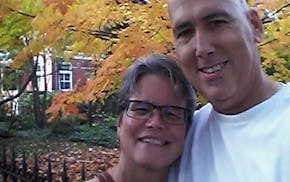Last week, Mayor R.T. Rybak tweeted the following message: "Number 1 again! Minneapolis ranked top city for drivers by Delivery Times Magazine due to abundance of bike lanes."
Bicycle delivery people across the city no doubt did wheelies over the news. But as I sat in a traffic jam on my way home from work this week, looking wistfully at the empty bike lane next to me that used to be for cars, I had to wonder if everyone was so jubilant.
It's hard to argue against creating safer biking paths in the cities, or against the fact that biking is good for you and the environment. I bought a new bike last year and like to ride it around town. I like the new lanes when I'm riding my bike.
But last week I kept track of the number of bikes I saw in the new bike lanes on my way to work. I counted three. All week. Like a lot of other drivers, I've also frequently been flummoxed on what to do when my car lane suddenly becomes a bike lane, or has a large painting of a bike in it.
I am apparently not alone. I checked comments on a recent story we did about a new bike lane in south Minneapolis.
Here is one: "19th Ave S, the 10th Ave bridge, and 10th Ave. SE are now a complete mess. [There are] bottlenecks that were apparently designed to discourage drivers and divert them to [nonexistent] alternate routes. "
And another: "Riverside Avenue, the Franklin Avenue bridge and Marshall Avenue in St. Paul are frequently jammed with cars backed up for blocks. Sitting there in traffic, looking at a wide open empty lane next to me is frustrating. I think bike commuting is great, but the engineering of these new bike paths is ridiculous. It's just not working. Traffic flow is in a dead stop."
And another: "The whole bike thing is totally out of control in Minneapolis and the city leaders need a reality check before moving forward to give these bikers more psycho biking freedom."
Over in St. Paul, a group of residents, Local Taxpayers for a Livable Community (LTLC), has fought a bike lane through their neighborhood, arguing that changes made on Jefferson Avenue actually made traffic less safe, and diverted cars onto side streets where kids play. They raise some logical questions about how much of our roads, and money, we should devote to the 4 percent of people who commute by bike.
Clare Malloy Bluhm is one of the members of LTLC and says the group spans the political spectrum. "I think our voice isn't being heard," she said. "We keep hearing that St. Paul wants to be like Portland, and I always ask, 'How long does the snow last in Portland?' "
I'm all for the cities encouraging alternative transportation, but like Bluhm I also think that not wanting to ride your bike from November to April is a pretty sane, legitimate option.
My avid biker friends all say the reason there are problems is because motorists routinely ignore bike lanes and the state-mandated 3-foot buffer for bikes. Probably. But it's my observation that for every Danica Patrick motorhead wannabe, there's a Spandex-clad Lance Armstrong egomaniac weaving through traffic and running red lights.
I'm hoping the new lanes will help, but I'm not betting on it.
Meanwhile, I called the guy responsible for catching the grenades for the city: Shaun Murphy, who holds the only-in-Minneapolis title of non-motorized transportation programmer.
35 miles of new bike trails
Murphy said Minneapolis has added 35 miles of bike trails in the past year, about 25 of them on city streets. Residents who call 311 to comment fall into three roughly equal camps: The pleased, the puzzled and the perturbed.
Murphy acknowledged that the areas mentioned in the Star Tribune comments have been problems reported by commuters, but they seem to be lessening as people choose alternate routes. The city is using the feedback to tweak the projects, he said.
One woman called to say she was stuck in a jam on Riverside, and there were no bikes in the bike lanes. "I drive and I don't like to be stuck in traffic either," said Murphy. "It's part of the trade-offs. In some of these places, there have also been huge safety improvements for both cars and bikes. It's a balancing act, and we have to compromise."
Murphy said instructions on new lanes and markings are coming soon. Meanwhile, here's a quick lesson: If it's a solid line with a bike symbol, don't drive there; if it's a dotted line, yield to bikers. And if there's just a bike stencil, be aware of bikes and share the road.
In other words, I won't drive like Danica Patrick if you move over and quit pretending you are Lance Armstrong.
jtevlin@startribune.com • 612-673-1702

Tevlin: 'Against all odds, I survived a career in journalism'

Tevlin: Grateful Frogtown couple fight their way back from fire and illness




